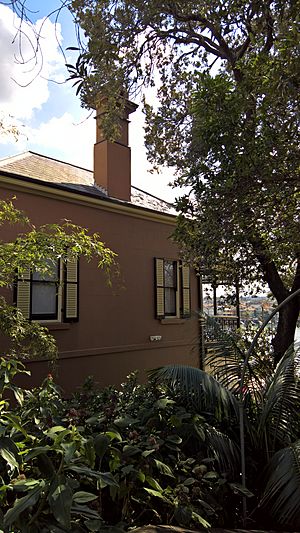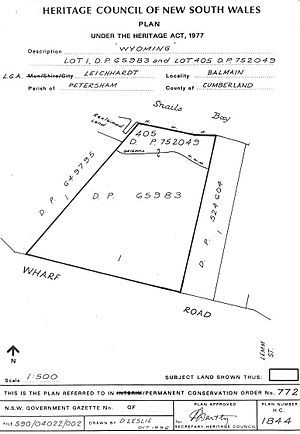Wyoming, Birchgrove facts for kids
Quick facts for kids Wyoming |
|
|---|---|

Wyoming, Birchgrove
|
|
| Location | 25 Wharf Road, Birchgrove, Inner West Council, Sydney, New South Wales, Australia |
| Official name: Wyoming | |
| Type | state heritage (built) |
| Designated | 2 April 1999 |
| Reference no. | 772 |
| Type | Other - Residential Buildings (private) |
| Category | Residential buildings (private) |
| Lua error in Module:Location_map at line 420: attempt to index field 'wikibase' (a nil value). | |
Wyoming is a special old house located in Birchgrove, Sydney, Australia. It's listed on the New South Wales State Heritage Register, which means it's an important historical place that needs to be protected. It was added to this list on April 2, 1999.
Contents
A Look Back at Wyoming's History
Wyoming was built in 1881 by Quarton L. Deloitte. It was built around an even older stone cottage called "The Hermitage." This cottage was once home to a ship builder named James Yeend in the 1870s. The famous Mansfield Bros. designed Wyoming. They were a top architecture firm in Victorian times and designed many public buildings, like Balmain Primary School.
Who Was Quarton L. Deloitte?
Quarton L. Deloitte was the son of a sea captain. He grew up nearby and worked as the secretary for the Colonial Sugar Refinery (CSR) for 50 years. He was a very important person in Balmain and supported the Sydney Rowing Club for many years. People often called him the "father of rowing." His family lived in the Birchgrove area for almost 100 years. Deloitte loved gardening and created beautiful terraced lawns, trees, shrubs, and a glass house at Wyoming.
The Famous Scientist Who Lived Here
In 1884, a legendary Russian scientist and explorer named Nicholas Miklouho-Maclay lived in Wyoming with his wife, Margaret. Margaret was the daughter of Sir John Robertson, who was the Premier of New South Wales five times.
Miklouho-Maclay is not very well known in Australia, but he is a hero in Russia and the Ukraine. He set up a biological research station at Watsons Bay. He also explored and studied people in New Guinea and the Solomon Islands. Because of him, Wyoming became famous around the world.
Saving Wyoming from Demolition
After Deloitte passed away in 1927, Wyoming was bought by nearby shipping companies. It was forgotten and not taken care of for a long time.
In 1989, the house was almost torn down. The owners wanted to build 10 townhouses there. But people fought to save it! The Soviet Consul General, Ivan Shchbakov, even spoke at a local council meeting. This meeting was filmed and shown on TV in the Soviet Union. The local council voted to stop the demolition and asked the government to protect the house. This led to Wyoming being listed on the NSW State Heritage Register.
Bringing Wyoming Back to Life
Starting in 1994, a plan was made to restore Wyoming. Expert architects, Clive Lucas, Stapleton & Partners, led the work. They added a new conservatory-kitchen and opened up the closed-in verandahs. They also removed many kitchens and bathrooms from when the house was divided into flats. This careful work kept most of the original parts of the house.
Old photos from a 1929 magazine helped them find many hidden things. They found original iron decorations, parts of the first-floor verandah, and pieces of the Orchid house. They also discovered old drainage channels, a well from the 1860s, and stone flooring from the 1850s.
The Beautiful Gardens of Wyoming
The restoration of the Victorian garden started in 1999. A landscape architect named Michael Lehany designed a beautiful Victorian garden in front of the house. This included a cactus garden, which was a smart idea even before water restrictions became common. Old stone fences and paths were fixed or rebuilt. Many traditional plants were added to what was already there.
The garden has special plants like orchids, cacti, succulents, and bamboos. There are also many different frangipani trees. A very old evergreen oak tree from the Mediterranean, called Quercus ilex, still stands near the street.
The old dock area was also restored around 2000. Part of it was rebuilt with granite from Moruya, which was leftover from building the Harbour Bridge. The rest was rebuilt with large sandstone blocks. A new garden was designed and planted along the waterfront in 2011.
The Orchid House and Fernery
Deloitte loved collecting orchids and built a Victorian Orchid house. This is a rare building to find on Sydney Harbour. It needed a lot of repair. He also built a fernery by the water, which replaced old shipyard sheds. It had a huge vaulted roof made of slats. Sadly, a sewer line was built through the back of the fernery in 1904, which damaged the area. The roof eventually fell apart.
Because little is known about the original fernery, no attempt was made to rebuild a "period" garden there. Instead, the area was cleared of rubbish and weeds. A simple pergola was built for shade. All the materials for this work had to be brought in and out by barge, which was a big job!
During World War II, the area was filled with soil to create a vegetable patch. This has been brought back. The old dock is now a bog garden.
What Does Wyoming Look Like?
Wyoming is a large, two-storey house built in the Italianate style. It has walls made of brick that are covered in a smooth finish. There's an addition at the back from around 1900 with a corrugated asbestos cement roof. Wyoming is a great example of a Victorian Italianate house by the water. It also has a large, beautiful garden. The house and garden add to the beauty of the area and can be seen from the water.
The outside of Wyoming has a slate roof with tile hips and ridges, and unique chimneys. Inside, it has a typical Victorian layout with a central staircase. The main house has a part that sticks out on the east side and a tower-like room on the west side. The front of the house used to have an original timber and cast iron verandah. This verandah was later enclosed and turned into bathrooms, kitchens, and bedrooms.
The garden has native trees and is surrounded by a cast iron gate. A glass house, which was in bad shape for many years, was rebuilt in the 1990s. At that time, the garden was replanted carefully to match its historical style.
Changes Over Time
- The verandahs were filled in, and later interesting additions were made on the street side.
- Windows were changed.
- The entry lobby and rear staircase were updated.
- The verandah has cast iron columns and stone steps. The sea walls were also rebuilt.
- A big restoration project has been ongoing since 1995.
Why Wyoming is Important
Wyoming is a very important building because of its beautiful architecture, its location, how well it has been kept, and its historical connections. It's one of the last Victorian houses left on the Balmain Peninsula that is right on the waterfront.
Architecturally, it's a wonderful example of the Italianate style. It was designed by the Mansfield Brothers, who were among Sydney's best architects in the mid-Victorian era. The house is a landmark for Snails Bay and Sydney Harbour. It also adds to the historical feel of Wharf Road and still has its original Victorian garden.
Wyoming is important locally because of its connection to Quarton Deloitte, who contributed a lot to the area and was a pioneer in Australian rowing. It is important for the state and even internationally because of its link to the famous Russian scientist and humanitarian, Nicolai Miklouho-Maclay.


